calsfoundation@cals.org
Davidsonville (Randolph County)
Davidsonville, founded in 1815, was perhaps the most important frontier settlement in northeast Arkansas. Though abandoned by the 1830s, it was the site of several Arkansas “firsts.” While a part of Missouri Territory’s Lawrence County, it was the location of the first post office in what would become Arkansas. In 1820, Arkansas Territory’s first federal land office was also established there, and the first Arkansas courthouse was built in 1822. For approximately fifteen years, the town was an important gathering place for local politics and commerce.
The area was first occupied during the Archaic Period (9500–650 BC) and as late as the early 1700s by the Osage, Shawnee, Delaware, and others. Modern archaeological evidence confirms that the town was built on a Native American village site.
Many of the early European settlers to the area were of French origin, and, by 1804, a small settlement is believed to have existed in the area. In 1811, a road was constructed beginning at St. Genevieve, Missouri, and entering present-day northeast Arkansas near what would become Davidsonville, increasing immigration to the area.
The political importance of the area drastically changed when, on January 15, 1815, much of present-day northern Arkansas was established as Lawrence County, Missouri Territory. The circuit court, which met in the home of Solomon Hewitt, was charged with acquiring a site for a county seat. Land—which was chosen due to its close proximity to the Black, Spring, and Current rivers and the lone road through the area—was soon purchased for $255 from five local French settlers. About 1815, surveyor James Boyd platted the town site. Initially named Lawrence, it eventually consisted of approximately 35 acres located on the west bank of the Black River. The area between the town and the river, which contained a blacksmith and the public well, was called “the Commons.” Soon after the survey, former Missouri Territory legislator John Davidson, who became an important influence in the town’s development, settled in the area. By 1817, the name of the town had been changed to Davidsonville. Davidsonville remained the county seat for approximately fourteen years.
The settlement soon became a center of political activity and local commerce. On June 28, 1817, the first United States postal stop in what would become Arkansas was established at Davidsonville, with Adam Richie (or Ritchey) as the first postmaster. Still, in 1819, traveler Henry Schoolcraft described the town as a place of “little note or importance at the present.” Once the area’s first courthouse, a two-story brick structure, was constructed in 1822, the town began to prosper. A log jail was also constructed northwest of the building. Though the population never numbered more than a few hundred, archaeological evidence shows that the town’s residents were using goods from as far away as New Orleans, Louisiana, and the East Coast.
The town’s importance increased when, in 1820, the federal government established Arkansas Territory’s first land office there. The Black River connected the town to trade routes, and a ferry across the Black River connected the town to the road that led to Memphis, Tennessee. At the time, the commercial center consisted of a few businesses and a cotton gin. In that same year, traveler John Meetch described the town as having about ten to fifteen houses.
The town prospered for more than a decade but experienced a sudden decline due to a number of factors. Some say that an epidemic, perhaps cholera, decimated the population and led to abandonment of the town. Economic factors were probably the true cause, however. The rivers, which contributed to the importance of the town, also led to its decline. The area was prone to flooding, isolating the area for much of the time. The rerouting of the Southwest Trail, the major road through the area, away from the town as well, as the growth of nearby Pocahontas (Randolph County) and Batesville (Independence County), the latter some fifty miles to the south, contributed to the decline. In 1829, the Randolph County seat was moved approximately fifteen miles to the west to the new town of Jackson. About the same time, the U.S. land office was moved to Batesville. Having lost its governmental importance, the town slowly died. For a brief period, it retained its role as a commercial center with a ferry maintained by a local family until the 1930s.
The town would be all but forgotten if not for the establishment of a 163-acre state park. Legislation was passed in 1957 to preserve the town site, but the town site was not purchased until two years later. Today, Davidsonville Historic State Park preserves what remains of the town.
For additional information:
McLeod, Walter. Centennial Memorial History of Lawrence County. Russellville, AR: Russellville Printing Company, 1936.
———. “Early Lawrence County History.” Arkansas Historical Quarterly 3 (Spring 1944): 37–52.
Stewart-Abernathy, Skip. The Seat of Justice 1815–1830: An Archeological Reconnaissance of Davidsonville, 1979. Arkansas Archeological Research Report No. 21. Fayetteville: Arkansas Archeological Survey, 1980.
Mike Polston
CALS Encyclopedia of Arkansas
 Louisiana Purchase through Early Statehood, 1803 through 1860
Louisiana Purchase through Early Statehood, 1803 through 1860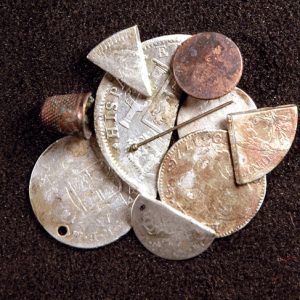 Davidsonville Artifacts
Davidsonville Artifacts 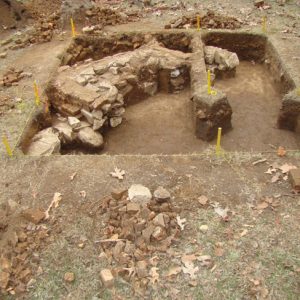 Davidsonville Excavation
Davidsonville Excavation 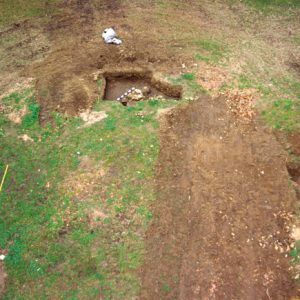 Davidsonville Courthouse Remains
Davidsonville Courthouse Remains 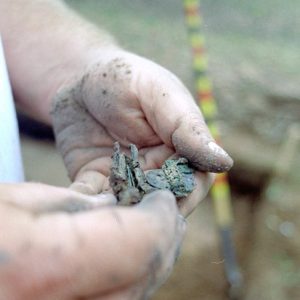 Davidsonville Artifact
Davidsonville Artifact 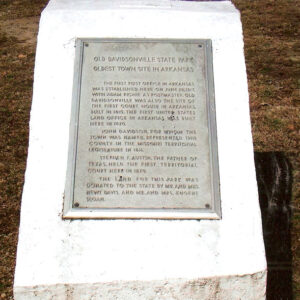 Davidsonville Plaque
Davidsonville Plaque 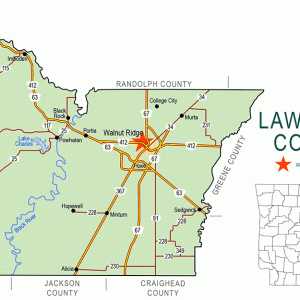 Lawrence County Map
Lawrence County Map  Wampum Beads
Wampum Beads 




Davidsonville is much closer to the Eleven Point and even the Fourche de Mas rivers than it is to the Current River. The most common epidemic mentioned as a cause for the decline of the town was yellow fever.